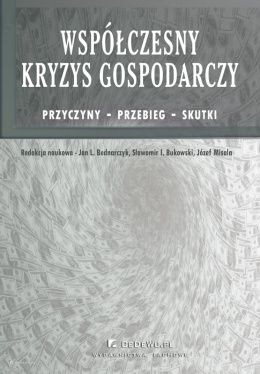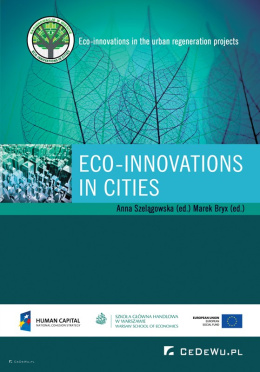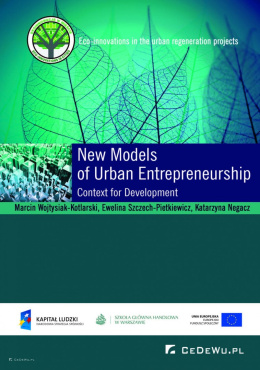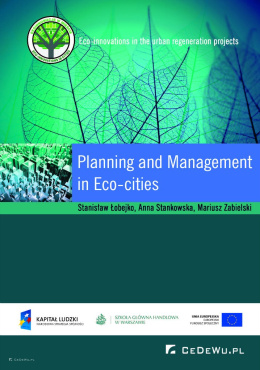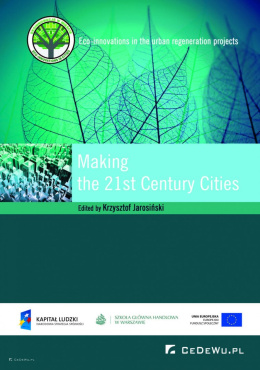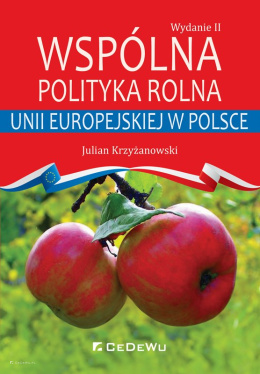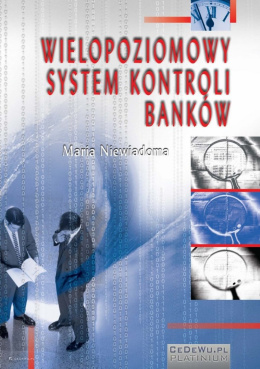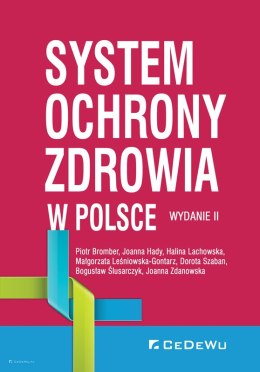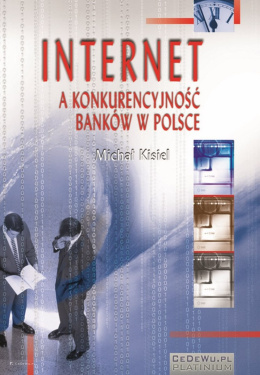- Kategorie
-
Eco-cities: Challenges, Trends and Solutions
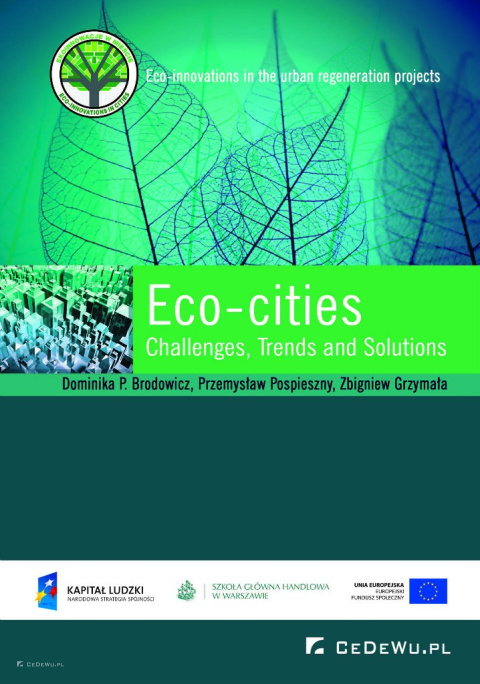
The challenges lying ahead of the contemporary urban areas, specifically cities are formidable. These include growing population, air pollution, congestion, energy efficiency and growing demand for high quality of living. Although they are varied and can appear as seemingly unrelated, more often they appear on international agendas of the United Nations, European Union and various non-governmental organisations (NGOs) under the overarching umbrella of sustainability or strictly as a green agenda. „Eco-cities: Challenges, Trends and Solutions" e-book is an introduction to this dynamically developing and evolving area of green innovations taking place in contemporary cities, with a specific focus on cases from Europe and North America. This publication is divided into three parts including typology of green cities, information technologies applied in the urban areas (smart cities) and legal requirements leading towards green future of urban areas. Wyzwania leżące przed współczesnymi obsz
| Wysyłka w ciągu | 24 godziny |
| Kod kreskowy | |
| ISBN | 978-83-7941-216-7 |
| EAN | 9788379412167 |
Download
Pobierz plik: E-book 2 – Eco-cities - Challenges, Trends and Solutions (pdf)
The challenges lying ahead of the contemporary urban areas, specifically cities are formidable. These include growing population, air pollution, congestion, energy efficiency and growing demand for high quality of living. Although they are varied and can appear as seemingly unrelated, more often they appear on international agendas of the United Nations, European Union and various non-governmental organisations (NGOs) under the overarching umbrella of sustainability or strictly as a green agenda. „Eco-cities: Challenges, Trends and Solutions" e-book is an introduction to this dynamically developing and evolving area of green innovations taking place in contemporary cities, with a specific focus on cases from Europe and North America. This publication is divided into three parts including typology of green cities, information technologies applied in the urban areas (smart cities) and legal requirements leading towards green future of urban areas.
Wyzwania leżące przed współczesnymi obszarami zurbanizowanymi, w szczególności miastami są ogromne. Wśród nich znajdują się kwestie związane z rosnącą populacją, zanieczyszczenie powietrza, korki, konieczność zapewnienia efektywności energetycznej w budynkach i rosnące aspiracje ludności do zapewnienia wysokiej jakości życia. Pomimo tego, że te wyzwania są one zróżnicowane i mogą wydawać się jako pozornie niepowiązane, pojawiają się coraz częściej w dyskusjach na poziomie międzynarodowym, w tym na forum Organizacji Narodów Zjednoczonych (ONZ), Unii Europejskiej (UE) i wielu organizacji pozarządowych pod hasłem zrównoważonego rozwoju, a bardziej szczegółowo jako zielona agenda. Publikacja opracowana w jęz. angielskim "Eco-cities: Challenges, Trends and Solutions" jest wprowadzeniem do dynamicznie rozwijającej się tematyki związanej z zielonymi miastami ze szczególnym uwzględnieniem obszaru Europy i Ameryki Północnej. Jest ona podzielona na trzy części dotyczące typologii zielonych miast, zastosowania nowoczesnych technologii informacyjnych na obszarach zurbanizowanych (inteligentne miasta) oraz legislacji.
UWAGA! WSZELKIE ZAMÓWIENIA, RÓWNIEŻ NA DARMOWE E-BOOKI REALIZUJEMY W GODZINACH PRACY FIRMY
10.00 - 18.00 - OD PONIEDZIAŁKU DO PIĄTKU
PO WERYFIKACJI ZAMÓWIENIA PRZEZ PRACOWNIKA.
List of Acronyms 7
Publisher's note 10
Introduction 12
PART I
Typology and 'components' of eco-cities
Chapter 1
Typology of green cities - Dominika P. Brodowicz 14
Introduction 14
1.1. Greening of cities 14
1.2. Eco-city 15
1.3. Typology of cities branded around green issues 17
1.4. City branding 19
1.4.1. Eco-branding 23
Conclusions 25
References 26
Web references 26
Chapter 2
Trends affecting the 21st century cities - Dominika P. Brodowicz 27
Introduction 27
2.1. Cities and challenges 27
2.2. Academic approach 28
2.3. Industry approach 32
2.4. Regional approach 34
Conclusions 38
References 38
Web references 38
Chapter 3
Public participation and social engagement in greening the cities - Dominika P. Brodowicz 39
Introduction 39
3.1. Top-bottom approach to participation and engagement of the society 39
3.2. Bottom-up approach to participation and engagement of the society 42
3.2.1. Water - Friends of the Chicago River 42
3.2.2. Waste - Keep America Beautiful (KAB) 43
3.2.3. Green space - guerrilla gardening and city farming 44
Conclusions 45
References 46
Web references 46
Chapter 4
Green buildings and certification - Dominika P. Brodowicz 47
Introduction 47
4.1. Green buildings 47
4.2. Certification 48
4.2.1 BREEAM 48
4.2.2. LEED 51
4.2.3. Energy performance of buildings in the EU 54
Conclusions 56
References 57
Web references 57
PART II
High-technologies in cities operations
Chapter 5
Green Urban Technologies - Przemyslaw Pospieszny 59
Introduction 59
5.1. From green urban technologies to smart cities 59
5.1.1. Green technologies 59
5.1.2. Smart cities 61
5.1.3. Urban analytics - sensors, open data and knowledge discovery 64
5.2. Efficient districts 70
5.2.1. Energy management 70
5.2.2. Water management 74
5.2.3. Waste management 78
5.2.4. Smart buildings and management systems 79
5.2.5. Smart transportation 81
Conclusions 85
References 85
Web references 86
Chapter 6
Green Urban Transportation - Przemyslaw Pospieszny 88
Introduction 88
6.1. Challenges and opportunities 89
6.1.1. Urbanisation, congestion and transport demand 89
6.1.2. Climate change, pollution and health 91
6.1.3. Resources consumption 93
6.2. Green transportation 96
6.3. Public transportation 100
6.3.1. Bus transit 101
6.3.2. Rail transit 105
6.4. Personal vehicles 108
6.5. Bike friendly cities 111
6.6. Walkable cities 114
Conclusions 116
References 117
Web references 118
PART III
European and American legal requirements and strategies towards green cities development
Chapter 7
Fundamental plot - a reason for introduction of Europe 2020 Strategy - Zbigniew Grzymała 120
Introduction 120
7.1. The main goals of the Strategy 121
7.2. Flagship initiatives 122
Conclusions 123
References 124
Chapter 8
European and American strategies towards green cities development - Zbigniew Grzymała 125
Introduction 125
8.1. Europe 2020 Strategy 126
8.2. EU Initiatives 128
8.2.1. Smart Citizens and Smart Government 128
8.2.2. Smart Cities 129
8.2.3. Smart Energy and Climate Change 130
8.2.4. Smart Regions 131
8.3. American strategies 131
8.3.1. Pass green building codes 132
8.3.2. Cost-effectively finance energy efficiency 133
References 134
Web references 134
About authors 136
Dominika P. Brodowicz PhD 136
Przemyslaw Pospieszny 136
Professor Zbigniew Grzymała 137
Figure of contents 138
Table of contents 140
Dominika P. Brodowicz PhD
Assistant Professor in Innovative City Unit, Warsaw School of Economics with over seven years of experience in academic teaching.
Holds a PhD degree from College of Engineering & Built Environment, Dublin Institute of Technology.
Main fields of research are green and smart cities; sustainable and green development of urban areas in Europe, eco-economics; green buildings, responsible property investment, Futures Studies and long-term planning methods.
Przemyslaw Pospieszny
Doctoral Candidate at Business Computing Institute, Warsaw School of Economics. For last 8 years he has been working as a Project Manager and Business Analyst in financial industry on implementation of various IT solutions.
Przemyslaw received his MSc in Business Computing from Poznan University of Economics in Poland (2006) and PgD in Knowledge Management from Dublin Institute of Technology in Ireland (2007). Additionally he holds a Project Management Professional (PMP) certificate from Project Management Institute.
His current research focuses on data mining, project management and smart cities, in particular urban analytics and modeling, mobility and transportation within urban areas, and green technologies.
Professor Zbigniew Grzymała
Academic teacher at Warsaw School of Economics in Warsaw. From 1999 junior member of teaching staff. From 2000 assistant professor and from 2011 professor and manager of Economic and Finance of Local Government Department.
Lectures in the following areas: economy of public sector, eco-cities, enterprise theory, economic and finance analysis, restructuring of municipal sector, economy of public sector, etc.
Polub nas na Facebooku

